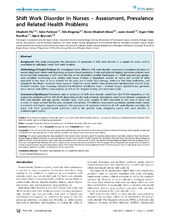| dc.description.abstract | Background: This study investigates the prevalence of symptoms of shift work disorder in a sample of nurses, and its association to individual, health and work variables. Methodology/Principal Findings: We investigated three different shift work disorder assessment procedures all based on current diagnostic criteria and employing symptom based questions. Crude and adjusted logistic regression analyses were performed with symptoms of shift work disorder as the dependent variable. Participants (n = 1968) reported age, gender, work schedule, commuting time, weekly work hours, children in household, number of nights and number of shifts separated by less than 11 hours worked the last year, use of bright light therapy, melatonin and sleep medication, and completed the Bergen Insomnia Scale, Epworth Sleepiness Scale, Global Sleep Assessment Questionnaire, Diurnal Scale, Revised Circadian Type Inventory, Dispositional Resilience (Hardiness) Scale – Revised, Fatigue Questionnaire, questions about alcohol and caffeine consumption, as well as the Hospital Anxiety and Depression Scale. Conclusions/Significance: Prevalence rates of symptoms of shift work disorder varied from 32.4–37.6% depending on the assessment method and from 4.8–44.3% depending on the work schedule. Associations were found between symptoms of shift work disorder and age, gender, circadian type, night work, number of shifts separated by less than 11 hours and number of nights worked the last year, insomnia and anxiety. The different assessment procedures yielded similar results (prevalence and logistic regression analyses). The prevalence of symptoms indicative of shift work disorder was high. We argue that three symptom-based questions used in the present study adequately assess shift work disorder in epidemiological studies. | en_US |

